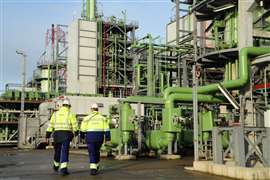5 ways to reduce diesel engine emissions
17 March 2024
The drive to zero emissions has led many engine and powertrain companies to adopt non-IC-engine technologies. This typically means an electric power source of some kind. Nonetheless, diesel engines continue to be manufactured, and thus, reducing emissions remains a top priority.
In the January-March print issue of Power Progress International, editor Julian Buckley looked at a variety of technologies being used to reduce diesel engine emissions as well as their pros and cons. You can read his full story online, but below are excerpts of it that address five ways diesel emissions can be reduced.
Using Alternative Fuels
 Sustainable fuel maker Neste’s refinery in Rotterdam, Netherlands, where the company manufactures HVO. Source: Neste Oyj.
Sustainable fuel maker Neste’s refinery in Rotterdam, Netherlands, where the company manufactures HVO. Source: Neste Oyj.
Diesel engines need not burn petroleum diesel fuel. There are alternatives. Renewable diesel, also called hydrotreated vegetable oil (HVO), is one with particular promise. As it is chemically identical to petroleum diesel, it is a drop-in replacement, which means it can power a diesel engine with no modifications.
A recent Power Progress story looked at why HVO was chosen as the magazine’s 2023 Newsmaker of the Year. “There are no molecules in the HVO that you don’t find in diesel fuel,” said Markku Honkanen, head of technical services for renewable fuel maker Neste, in that story, “so it is chemically very similar, except that it’s missing some of the nasty stuff that doesn’t burn cleanly.”
Another option is biodiesel. However, there are many differences between HVO and biodiesel. For example, biodiesel is chemically different than petroleum diesel, giving it different properties.
“Because of the chemistry of biodiesel — it will grab water and turn it into a solvent, which is making it try to clean out the fuel tanks and lines that they had been running for a long time,” said Matt Leuck, technical services manager for Neste, in the aforementioned Power Progress story.
One engine taking advantage of this is the Perkins 2600 Series. Launched at a UK press event in September 2023, the 13-litre engine supports both HVO and biodiesel to reduce its carbon footprint.
Engineering Better Software
Software used to control an engine can also have a dramatic effect on emissions. California-based Tula Technology’s Dynamic Skip Fire (dDSF) software, for example, uses patented algorithms to decide whether to skip or fire individual cylinders to meet torque demands.
Liebherr Components and Tula conducted a joint study of the software on heavy machinery, with an eye to reducing greenhouse gas (GHG) and nitrogen oxide (NOx) in diesel engines. The study used a Liebherr D966 engine. In 2022, Power Progress reported on their results, which showed that in simulations of software, CO2 output was reduced by 9.5 percent, and NOx emissions dropped 41 percent.
Enhancing Turbochargers
Turbochargers add pressurized engine exhaust to the combustion chamber. This allows more fuel to be injected for an increase in engine power. It also reduces engine emissions.
 Cummins Turbo Technologies, makers of Holset brand turbochargers. (Photo: Cummins)
Cummins Turbo Technologies, makers of Holset brand turbochargers. (Photo: Cummins)
Cummins develops and manufactures its own turbocharger units, which are marketed under the Holset brand. The variable geometry that is part of the latest Holset VGT models supports delivery of short-route exhaust gas recirculation (EGR), which reduces NOx levels.
Brett Fathauer, executive director for research and engineering at Cummins Turbo Technology, said the company is looking to accelerate technology that will reduce CO2 emissions.
“We’re looking at air-handling tech, including compressors, turbines, efficiency improvements, together with e-machine upgrades and developments applicable to hybrid and fuel cell powertrains,” he said.
Buckley said next-generation chargers are set to take advantage of “pulsed” energy and redesigned shroud interfaces, each of which is intended to optimize the interaction between air flow and turbines and efficiently direct flow into the combustion chamber to deliver optimized power levels.
Improving Fuel Injection
Improving fuel injection technology is another approach to reducing emissions. For example, Bosch’s modular common-rail system for commercial vehicles (CRSN), which has been designed specifically for use in off-highway applications, features CRIN solenoid valve injectors that operate at up to 2,500 bar (36,259 psi). This atomizes fuel into microscopic droplets. The CRIN also rapidly switches, injecting “a specific quantity of fuel into the cylinders to match the driving situation,” according to the Bosch website. Both result in a cleaner burn, with lower CO2 and particulate emissions.
Addressing Cold Starts
According to a 2023 whitepaper published by the School of Mechanical Engineering at Nantong University in China in 2023, incomplete fuel combustion is unavoidable when the air and engine temperature are both low. The report quotes data that indicates NOx emissions from heavy-duty diesel engines in cold start conditions could increase by between 40 and 90 percent.
Alternative fuels such as HVO and biodiesel can help address this. According to the whitepaper, biodiesel can significantly reduce CO2 emissions. While there’s little change to NOx and hydrocarbons, these pollutants dropped farm more rapidly with biodiesel over petroleum diesel.
The whitepaper said heating system components is the best route for addressing cold-start emissions. It is part of the approach that UK-based aftertreatment systems maker Eminox is taking.
In an interview with Power Progress International, Anthony Greatwood, global product manager at Eminox, said the company is exploring ways to improve selective catalytic reduction (SCR) systems to address cold-start emissions. According to Greatwood, Eminox is investigating the introduction of a dual dose of diesel exhaust fluid (DEF) to the exhaust stream as well as heating the catalyst electrically to improve performance before engine temperature increases.
POWER SOURCING GUIDE
The trusted reference and buyer’s guide for 83 years
The original “desktop search engine,” guiding nearly 10,000 users in more than 90 countries it is the primary reference for specifications and details on all the components that go into engine systems.
Visit Now
STAY CONNECTED




Receive the information you need when you need it through our world-leading magazines, newsletters and daily briefings.
CONNECT WITH THE TEAM











